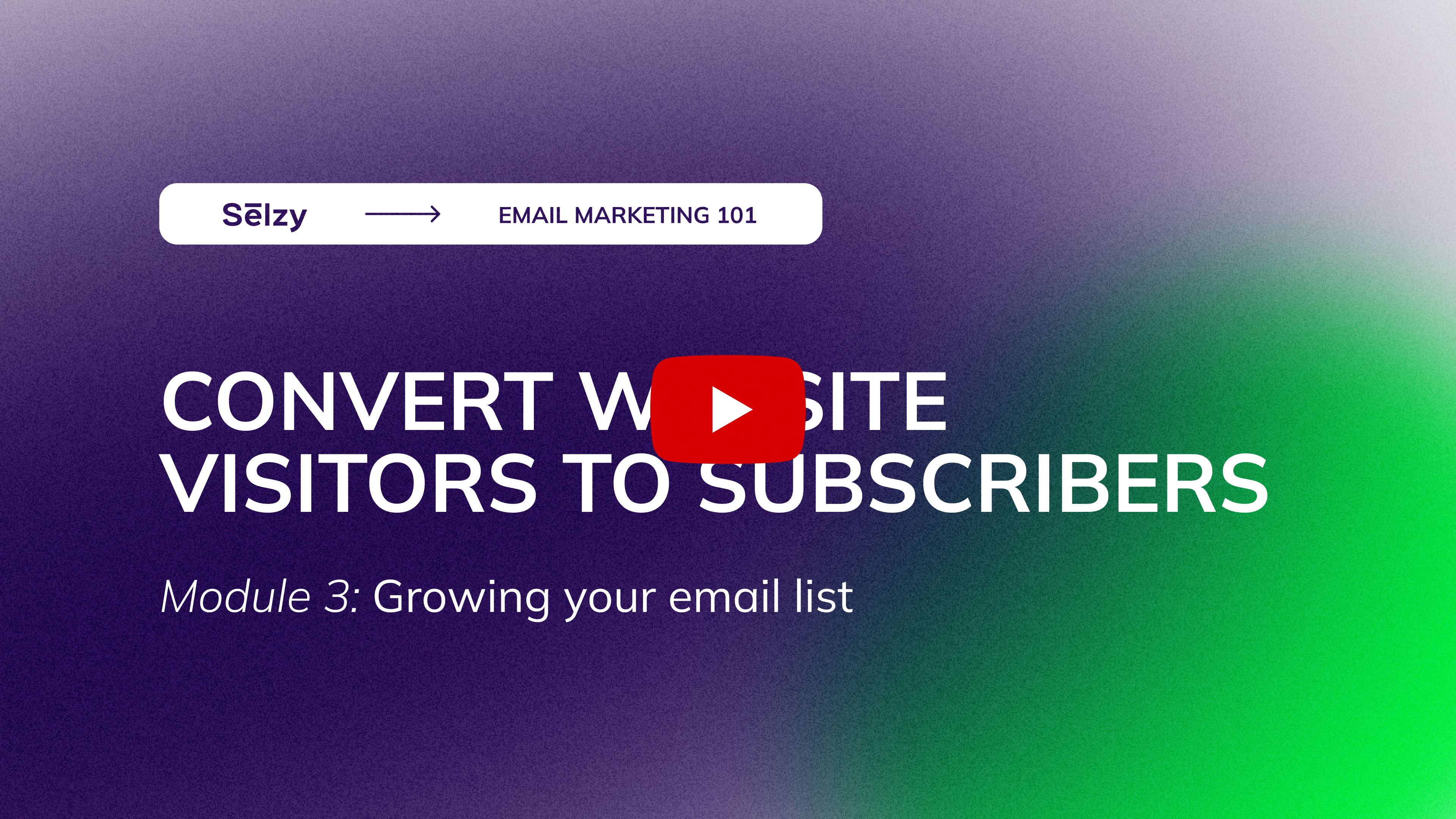Attracting New Subscribers with Website Sign-Up Forms
This is a transcript of lesson 6 of Email Marketing 101 Course by Selzy.

Welcome to Lesson 2 of Module 3. Here we’ll talk about the types of sign-up forms and how to set them up. If your brand has a website, you can start attracting new subscribers with a sign-up form.
The three main types of website sign-up forms are:
- Embedded forms
- Popup forms
- Sign-up pages
Let’s talk about embedded forms first
As the name suggests, embedded signup forms are embedded on a web page and you decide where you want to have one. Usually they can be found in the upper part to attract the most attention but not necessarily. Embedded forms come in many forms giving you space for creativity.

This visual is only available in a video lesson
An embedded form can be glued to the upper part of the screen…

This visual is only available in a video lesson
… or be tucked in next to blog articles on the right-hand side — these are just some common examples.

This visual is only available in a video lesson
They can also have a fixed and strategic position on a page, for example in a specific place in your content.

This visual is only available in a video lesson
Next type of signup forms we're going to talk about are popups
Popups are notorious for annoying users but if used correctly, they’ll get you new subscribers. In fact, pop-ups convert WAAAY better than embedded signup forms.

This visual is only available in a video lesson
Usually, a pop-up covers a part or all of the screen eliminating all the distractions and putting the message in focus.

This visual is only available in a video lesson
You can get creative with a popup and add gamification, for example with a spin-to-win popup.

This visual is only available in a video lesson
Selzy has a popup editor which allows you to play with text, colors, fields and pictures. You can also choose a pre-set template and heavily customize it to suit your needs. Switch to the mobile view to see how a popup will be displayed on a smartphone.

This visual is only available in a video lesson
To ensure your popups don’t distract and annoy potential subscribers, ensure your forms offer a clear value, and that they appear only once in a strategic manner. We’ll talk about all the must-do’s of creating a great pop-up a bit further in this lesson. Just one tip here: don’t forget to test it yourself to see what the people on your website experience!
Finally, you can use dedicated sign-up page as way to grow your list
The only function of a sign-up page is to capture new contacts. It contains only the essential elements to ensure nothing distracts the user which means it must remain clean.

This visual is only available in a video lesson
To create a great sign-up page follow these simple steps. First write a mini description to tell your potential subscribers what they get by giving you an email.

This visual is only available in a video lesson
Keep it to the necessary fields only with a clear call to action to make your message more focused. –end

This visual is only available in a video lesson
Now, Imagine, the opposite… a page with a little bit of everything: more fields, more tabs, more visuals, and a larger description. Then, it would be all over the place with no clear action to follow.

This visual is only available in a video lesson
Whatever website sign-up forms you use to attract new subscribers, follow these rules of thumb
Offer value and set the expectations. Explain to your potential subscribers what they get by giving their emails to you and how many times you’re gonna get them.
Limit the number of fields. If you omit specific fields like name, address or gender, potential subscribers will find signing-up faster. Just compare: how much easier this sign-up form would be…

This visual is only available in a video lesson
…if it only stayed focused on fetching an email
Design a clear call to action as well. Make it stand out so that visitors don’t have to wonder where they should click to subscribe. You can also write the targeted action right on the button (like, “GET MY PRIZE NOW”, save some space and reduce # of words..

This visual is only available in a video lesson
Include an image. Visuals attract people more than text. Studies claim that popups with images convert 84% better.
Give something in exchange. Don’t just ask for an email but offer something in return. Think of a lead magnet: a checklist, a free ebook, or a test drive of your product. This will make your signup form convert much better.

This visual is only available in a video lesson
Make it mobile-friendly. Statistically, signup forms convert 39% better on mobile than on desktop. So, make sure your popup doesn’t lag on mobile to not lose a potential audience member.
So far, we’ve talked about ways to build an email list through a website. But hey, of course these aren’t the only ways to add new contacts to your list. In the next video, we’ll talk about how to capture new subscribers upon registration or after purchase. Stay tuned!
This is a transcript of lesson 6 of Email Marketing 101 Course by Selzy.